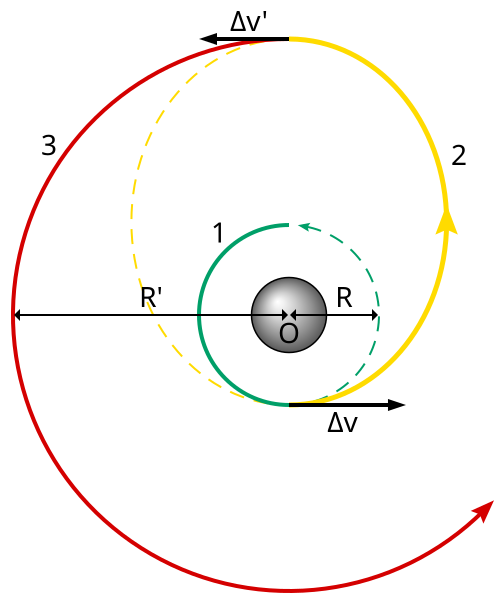Astrodynamics/In-Plane Orbit Changes
Introduction
[edit | edit source]Spacecraft Orientation
[edit | edit source]
To change your orbit in space, you must first determine what direction your spacecraft is pointing. The "forward direction," or the direction in which you are moving, is usually labeled "Prograde" The opposite direction is usually labeled "Retrograde".
Hohmann transfer
[edit | edit source]A Hohmann transfer is a transfer between two coplanar orbits with two burns. In a two-body system, it is almost always the most efficient transfer between two circular orbits in terms of ΔV.
Orbital transfers can be "Near Hohmann," meaning that they are still efficient, but not the most efficient. An example of a near Hohmann transfer orbit would be the Mars Reconnaissance Orbiter transfer orbit.
Bi-Elliptic transfer
[edit | edit source]A bi-elliptic transfer is a method to move an orbit to another. It can only be more efficient than a hohmann transfer in the case that the ratio of the final to initial semimajor axes is above 11.94. Hohmann transfers always take less time to complete than bi-elliptic transfers.
Spiral transfer
[edit | edit source]Low thrust spiral transfers are used when a low thrust engine such as an ion thruster or a solar sail is available. Such thrusters continuously add ΔV and require more total ΔV than Hohmann transfers.
Orbit Plane changes
[edit | edit source]Orbital plane changes are conducted at a point between the current and desired orbital planes called a node, which is where the current orbit intersects the line of intersection of the two planes, or the "Line of Nodes." There are two nodes at which this can take place, which can be either ascending or descending, depending on the direction from which they are approached. To change the plane on a descending node, you orient your spacecraft properly so that the thrust is propelling you in a direction referred to as "Orbit Normal." Your orbital plane will then start to align itself with the desired plane. To correct the plane at an ascending node, simply orient your spacecraft in the opposite direction, or "Orbit Anti-normal."
Orbit Phasing
[edit | edit source]
Orbit phasing is the adjusting of the true anomaly of a spacecraft's orbit, which can be done to conduct a rendezvous between two spacecraft. It is done by going into a certain phasing orbit that will change the true anomaly by an angle called the phasing angle. If the spacecraft is behind the target position in the same orbit, then a smaller orbit is required to "catch up" to the position. If the spacecraft is ahead of the target position, then the spacecraft will have to go into a larger orbit to "slow down" to that point.
Orbit Synchronization
[edit | edit source]For a spacecraft to dock with a space station, it must first synchronize its orbit with the station, or, in other words, "Hone in" on the station. This is done by executing orbital phasing burns to change the orbital period of the spacecraft, so that it begins to "catch up" to the station. When the station is within the desired range, another burn is executed to zero out the spacecraft's velocity relative to the station. After the relative velocity has been reduced to near zero, docking maneuvers are conducted.



